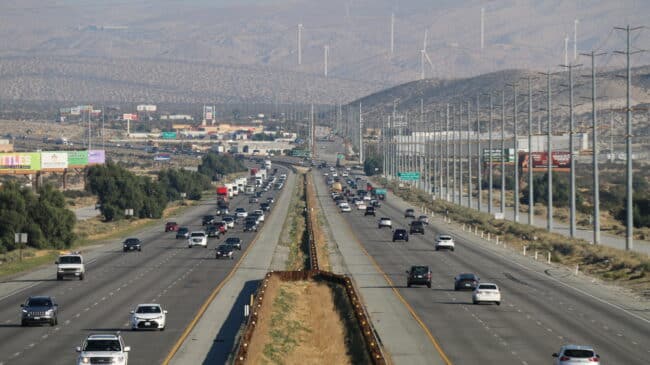Some much-needed traffic congestion-reduction projects in California are at risk of being canceled due to a little-noticed change that was legislated in 2013 but has taken about a decade to be fully implemented. California Senate Bill 743 requires highway policy to no longer focus on its traditional goal of improving level of service (LOS), which often leads to widening when traffic flow exceeds capacity. Instead, the focus must be on reducing vehicle miles of travel (VMT). This is part of the state’s carbon reduction strategy, which assumes that making people drive less is the best way to reduce greenhouse gas emissions (GHGs).
And California is not the only state that has made a shift to vehicle miles traveled reduction goals. While California’s goal is the most extreme, aiming for 20% less VMT by 2030, Washington state’s goal is 15% less VMT, Colorado’s goal is an 8% reduction, Minnesota 7%, and Massachusetts 3% less VMT.
I recently learned of two California projects, both of which have local support, that were nearing the approval finish line. Both projects are now under threat of cancellation based on the idea that any expansion of highway capacity will induce travel that would not otherwise have taken place. One project seeks to add express toll lanes to congested I-80 between Sacramento and Davis. The other is a set of arterial upgrades in communities south of Sacramento, such as Elk Grove.
Anti-highway activists cite an “Iron Law of Freeway Expansion,” based on a 2011 academic paper by Gilles Duranton and Matthew Turner. Their model of urban Interstate widening claimed to show that expanded freeways always fill up—hence, widening is futile. Their actual model did not calculate or even estimate how much of the new freeway traffic merely shifted from parallel arterials or from different times of day post-freeway expansion, so it’s not an “iron law” at all.
Transportation economist Steven Polzin has written widely on induced demand, pointing out a number of inconvenient facts that disprove the so-called iron law:
- In fast-growing states, increased traffic is due to increased population.
- Nationwide, VMT per capita stopped growing a decade ago.
- There are economic benefits to expanded highways, including better access to jobs, shopping, and (especially if the new capacity is priced express lanes) faster and more-reliable trips.
Several tools have been created that purport to calculate how much VMT will be induced by expanding a highway, one from the Rocky Mountain Institute (RMI) and another from the National Center for Sustainable Transportation. A version of the latter has been adopted in California and is called the California Induced Travel Calculator (CITC). Both assume that all increased vehicle miles of travel are bad, ignoring both economic benefits from improved mobility and, in many cases, increased safety by shifting trips to limited-access highways. The CITC assumes that all roads have the same kinds of response to expansion. It also implicitly assumes that long-haul truck trips will be “induced” to the same extent as personal trips. Some of the underlying assumptions in the model do not distinguish between correlation and causation in the studies on which the calculator’s model is based.
I’m dismayed that there has been little or no discussion among California transportation planners about the costs of this aggressive VMT-reduction effort. There is an increasing amount of academic research on the relationship between average metro area travel speed and economic productivity.
One of the first was a study of French cities by Remy Prud’homme and Chang-Won Lee, which found that, on average, a 10% increase in commuter miles traveled within 25 minutes was correlated with a 1.3% increase in the city’s economic productivity (Urban Affairs, 1999).
Among many subsequent studies, one by David Hartgen and Gregory Fields for Reason Foundation (2009) found a similar result in the San Francisco Bay Area, with a 10% speed increase correlating with 1% higher economic productivity.
Noted economic planner Alain Bertaud discussed this subject at length in Chapter 2, “Cities as Labor Markets,” of his book Order Without Design (MIT Press, 2018).
The University of Minnesota has conducted many “access to destinations” studies, looking at what fraction of a U.S. metro area’s jobs can be reached within various amounts of travel time—by car and also by transit. As is now widely known, in every metro area they studied, for a given amount of commute time (e.g., 30 minutes), cars always reach at least several times more jobs than transit. That’s intuitively obvious for two reasons: cars make the trip door-to-door using an extensive road network, while mass transit, on average, is slower and is almost never door-to-door.
Working Paper 30877 from the National Bureau of Economic Research, 2023, reports a big study comparing access to jobs in 109 U.S. and European cities, again via car and via transit. The researchers used Google Maps to construct car accessibility zones and transit accessibility zones and estimated travel times to the central business district by each mode for each city. While Europe obviously has more transit trips on average than the United States, the main finding was that “car travel offers overall larger accessibility across all time distances in both Europe and the U.S.”
If that’s the case for Europe, with much higher average urban area densities than the U.S., by what magic could California urban planners expect to densify its metro areas even to European levels and achieve better-than-European access to jobs?
Yet, California VMT reductionists are misguidedly counting on that to achieve their greenhouse gas-reduction goals rather than relying on the phase-out of internal combustion engines, for which California is far ahead of other states.
If California planners achieve their goal of reducing vehicle miles traveled by 20% by 2030, the likely result would be a serious decrease in the state’s urban area productivity, which would hurt the state and likely lead to even more companies and individuals moving from California to more productivity-friendly states.
A version of this column first appeared in Public Works Financing.

